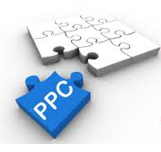Google Pay per click (PPC) (also called cost per click) is an internet advertising model used to direct traffic to websites, in which advertisers pay when the ad is clicked. It is defined simply as “the amount spent to get an advertisement clicked.”
Google PPC is quickly becoming an imperative tool in the staffing industry. Below are our Top 10 Google PPC Tips:
1) Search network vs Display network – In most cases you want to display your ads on the “Search Network” versus “Display Network”. Someone that is searching for what you offer versus someone that is presented with what you offer while browsing another site is more motivated. The search network are the ads that show on Google search results pages.
2) Location, Location, Location – If you will be targeting multiple geographic locations, create a campaign for each location. You can target more effectively at the Campaign level.
3) Build your negative keyword list – Negative keywords allow you to choose words that won’t trigger your ad. For example, if you are a new car salesman, place the word “used” on your negative list to target customers looking for a new vehicle. When used correctly and updated often, negative keywords help pare down your clickers to serious buyers and save your PPC dollars.
4) Write effective ad copy – With so much competition, you need to differentiate your ad. Are you running a promotion? Is shipping free? Offer value and then capitalize on it with a call-to-action. Use terms like “Learn More” and “Free Download” to draw in customers. Encourage searchers to act and let them know what to expect on the other side of the click.
5) Be Dynamic – Dynamic keyword insertion allows you to create more relevant ad copy by placing the exact phrase searched into your ad. When the potential customer sees the exact term they searched, they are more likely to click. While dynamic keyword insertion is very useful and can increase your click through rate tremendously, it is not for the PPC novice. If poorly executed, dynamic keyword insertion can result in ads that appear unclear and irrelevant and can drain your budget quickly.
6) Test and test again! – Don’t just set up a PPC campaign and hope for the best — proper testing and analysis are required. Metrics allow you to better understand your campaign and results, so set up A/B tests to track what works. Remember to test multiple ads simultaneously, but only allow for one variable at a time and run your tests long enough to gather proper data.
7) Timing matters – In addition to geo-targeting, PPC campaigns allow for time targeting. Analyze your metrics to determine when your ads are at their highest conversion rate. If you are receiving hundreds of clicks at 3 am, but making no sales, restrict ad impressions during those hours to save your budget.
8) Create targeted landing pages – Don’t throw away all your hard work by sending targeted customers to a non-targeted homepage. Create a simple landing page that picks up right where your ad left off. Don’t lose your visitor — and potential sale — by confusing them with unnecessary content.
9) Quality matters: Your Google Quality Score determines the overall ranking of your AdWords account and helps determine where your ads will place on the search page. Keep your score high by following the rules set up by Google AdWords and continuously providing quality advertisements. Stay on top of your Google Quality Score, as an unexpected drop is a red flag.
10) Check the search terms report – did you know you can see the actual search queries on Google that displayed your ad? This useful report is something you should pay close attention to. It will help you develop your negative keyword list and weed out non relevant searches from displaying your ads.
At ASJ Partners, our goal is to get your company found on the internet. If you have any questions, please feel free to contact us or call 610-930-5300.





